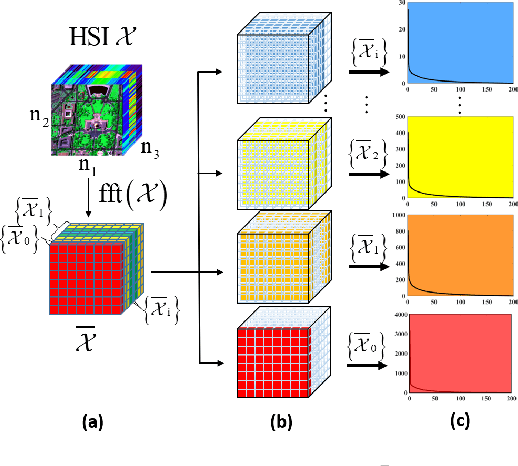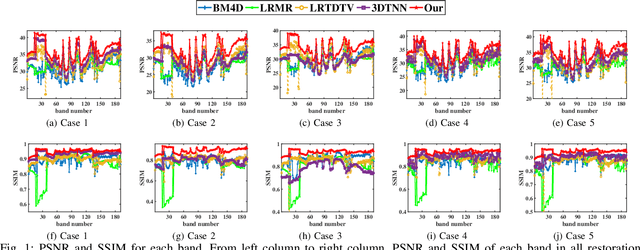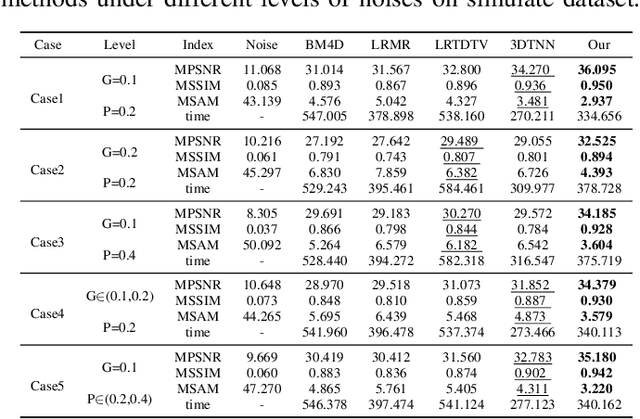Wenfeng Kong
Hyperspectral Target Detection Based on Low-Rank Background Subspace Learning and Graph Laplacian Regularization
Jun 01, 2023



Abstract:Hyperspectral target detection is good at finding dim and small objects based on spectral characteristics. However, existing representation-based methods are hindered by the problem of the unknown background dictionary and insufficient utilization of spatial information. To address these issues, this paper proposes an efficient optimizing approach based on low-rank representation (LRR) and graph Laplacian regularization (GLR). Firstly, to obtain a complete and pure background dictionary, we propose a LRR-based background subspace learning method by jointly mining the low-dimensional structure of all pixels. Secondly, to fully exploit local spatial relationships and capture the underlying geometric structure, a local region-based GLR is employed to estimate the coefficients. Finally, the desired detection map is generated by computing the ratio of representation errors from binary hypothesis testing. The experiments conducted on two benchmark datasets validate the effectiveness and superiority of the approach. For reproduction, the accompanying code is available at https://github.com/shendb2022/LRBSL-GLR.
Multi-modal and frequency-weighted tensor nuclear norm for hyperspectral image denoising
Jun 23, 2021



Abstract:Low-rankness is important in the hyperspectral image (HSI) denoising tasks. The tensor nuclear norm (TNN), defined based on the tensor singular value decomposition, is a state-of-the-art method to describe the low-rankness of HSI. However, TNN ignores some of the physical meanings of HSI in tackling the denoising tasks, leading to suboptimal denoising performance. In this paper, we propose the multi-modal and frequency-weighted tensor nuclear norm (MFWTNN) and the non-convex MFWTNN for HSI denoising tasks. Firstly, we investigate the physical meaning of frequency components and reconsider their weights to improve the low-rank representation ability of TNN. Meanwhile, we also consider the correlation among two spatial dimensions and the spectral dimension of HSI and combine the above improvements to TNN to propose MFWTNN. Secondly, we use non-convex functions to approximate the rank function of the frequency tensor and propose the NonMFWTNN to relax the MFWTNN better. Besides, we adaptively choose bigger weights for slices mainly containing noise information and smaller weights for slices containing profile information. Finally, we develop the efficient alternating direction method of multiplier (ADMM) based algorithm to solve the proposed models, and the effectiveness of our models are substantiated in simulated and real HSI datasets.
Hyperspectral Image Restoration via Multi-mode and Double-weighted Tensor Nuclear Norm Minimization
Jan 20, 2021


Abstract:Tensor nuclear norm (TNN) induced by tensor singular value decomposition plays an important role in hyperspectral image (HSI) restoration tasks. In this letter, we first consider three inconspicuous but crucial phenomenons in TNN. In the Fourier transform domain of HSIs, different frequency components contain different information; different singular values of each frequency component also represent different information. The two physical phenomenons lie not only in the spectral dimension but also in the spatial dimensions. Then, to improve the capability and flexibility of TNN for HSI restoration, we propose a multi-mode and double-weighted TNN based on the above three crucial phenomenons. It can adaptively shrink the frequency components and singular values according to their physical meanings in all modes of HSIs. In the framework of the alternating direction method of multipliers, we design an effective alternating iterative strategy to optimize our proposed model. Restoration experiments on both synthetic and real HSI datasets demonstrate their superiority against related methods.
 Add to Chrome
Add to Chrome Add to Firefox
Add to Firefox Add to Edge
Add to Edge